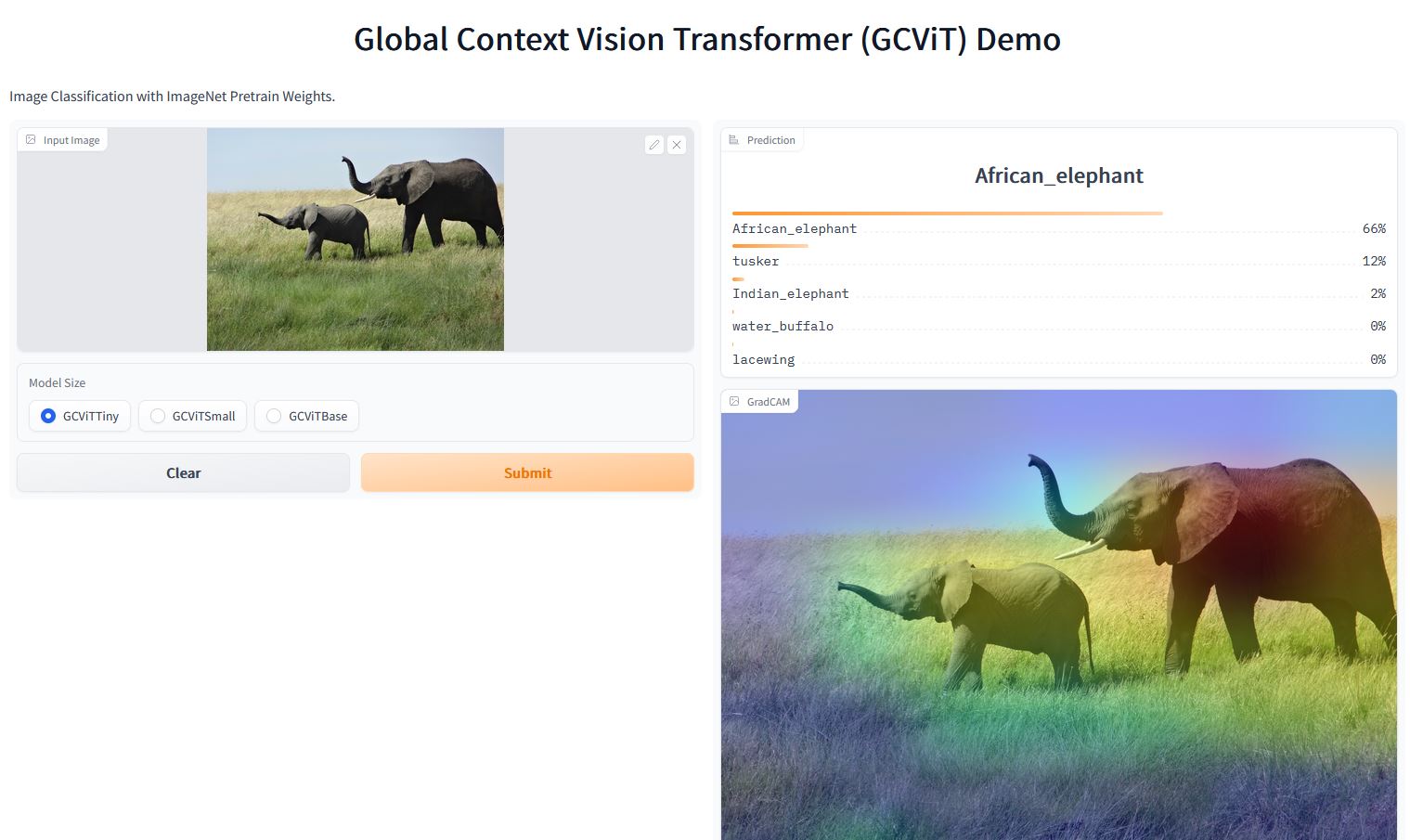Agenda¶
- This notebook explores the recently published (
20 Jun 2022) Global Context Vision Transformer (GCViT) architecture, with TensorFlow. - This notebook is not completely beginner friendly, we need to have previous knowledge of Matrix-Operation, Transformer, Self-Attention, WindowAttention, and a bit of CNN, check Reference section for links to the tutorials.
- It also gives a peek at GCViT in action with live-demo.
- It attempts to answer Why each component is used and How do they work under the hood.
- It also evaluates the model in ImageNetV2 dataset with ported weights from Official repo.
- It also demonstrates how can we Reuse its code for other tasks on different datasets with minimal change of code.
- It also shows how to train GCViT for custom dataset like Flower Classification.
Live Demo¶
Before we dive into the paper, if you want to see GCViT live in action like a "Desert before Dinner" person like me, I have created this WebApp with Gradio in HuggingFace Space,

Note: This app uses TensorFlow implementation of GCViT with ported weights from official repo.
Import Libraries¶
import tensorflow as tf
import tensorflow_addons as tfa
import matplotlib.pyplot as plt
import numpy as np
import sys
sys.path.append("../usr/lib/gcvit_utils") # building blocks which will be discussed below
from gcvit_utils import *
tf.autograph.set_verbosity(0)
tf.get_logger().setLevel(0)
1. Introduction¶
Note: In this section we'll learn about the backstory of GCViT and try to understand why it is proposed.
- During recent years, Transformers have achieved dominance in Natural Language Processing (NLP) tasks and with the self-attention mechanism which allows for capturing both long and short-range information.
- Following this trend, Vision Transformer (ViT) proposed to utilize image patches as tokens in a gigantic architecture similar to encoder of the original Transformer.
- Despite the historic dominance of Convolutional Neural Network (CNN) in computer vision, ViT-based models have shown SOTA or competitive performance in various computer vision tasks.

- However, quadratic [$O(n^2)$] computational complexity of self-attention and lack of multi-scale information makes it difficult for ViT to be considered as general-purpose architecture for Compute Vision tasks like segmentation and object detection where it requires dense prediction at the pixel level.
- Swin Transformer has attempted to address the issues of ViT by proposing multi-resolution/hierarchical architectures in which the self-attention is computed in local windows and cross-window connections such as window shifting are used for modeling the interactions across different regions. But the limited receptive field of local windows can not capture long-range information, and cross-window-connection schemes such as window-shifting only cover a small neighborhood in the vicinity of each window. Also, it lacks inductive-bias that encourages certain translation invariance is still preferable for general-purpose visual modeling, particularly for the dense prediction tasks of object detection and semantic segmentation.
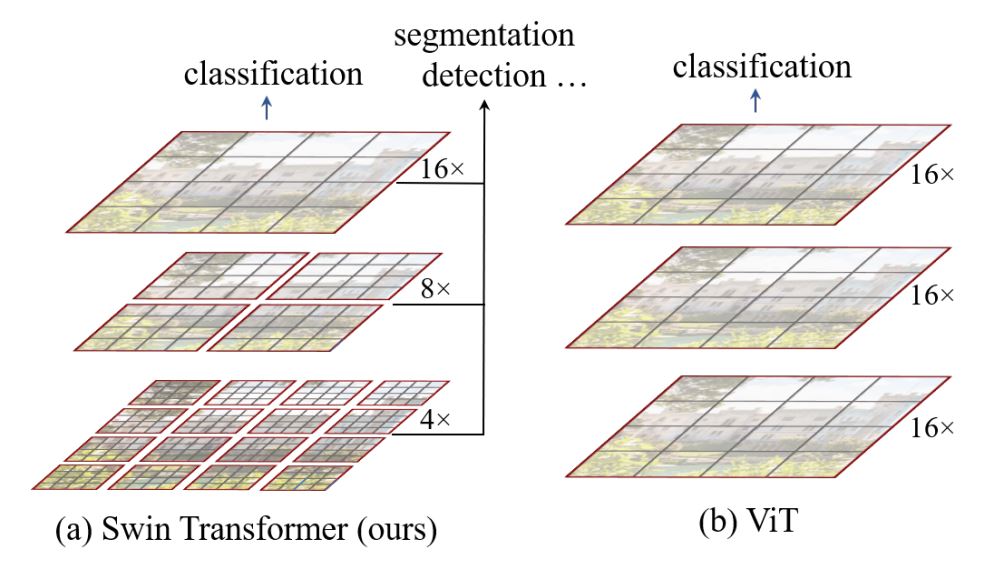
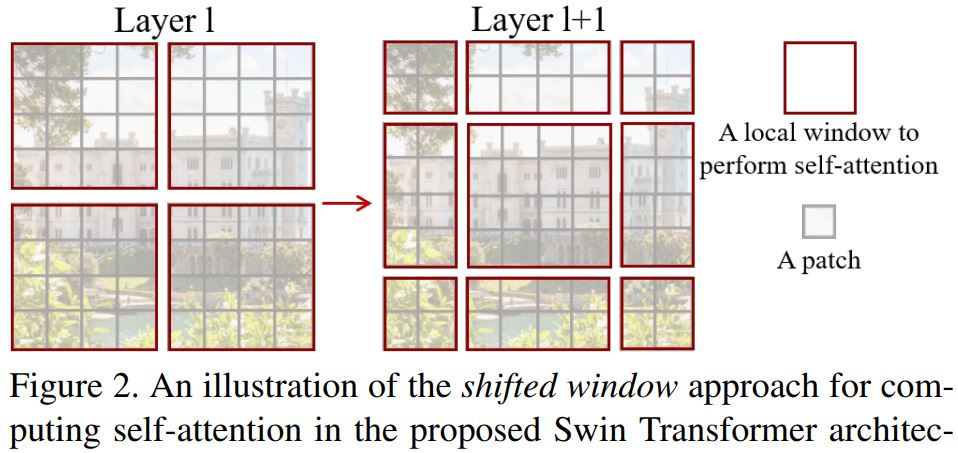

- To address above limitations, Global Context (GC) ViT network is proposed.
Summary:
Transformeris proposed to capture long-range information withself-attentionmechanism, but it comes withquadratic computationcost and lacksmulti-resolutioninformation. Later onSwin Transformerintroduceslocal-window-self-attentionto reduce the cost to linear w.r.t image size,shifted-window-attentionto capture cross-window information and finally exploitsmulti-resolutioninformation with hierarchical architecture. Butshifted-window-attentionstruggles to capture long-range information due to small coverage area ofshifted-window-attentionand lacksinductive-biaslike ViT. Finally,Global Context ViTis proposed to address limitations of Swin Transformer.
2. Methodology¶
- This paper proposes a novel architecture namely, Global Context Vision Transformer (GCViT) that utilizes window attention mechanism similar to Swin Transformer.
- Unlike Swin Transformer this paper uses global context self-attention, with local self-attention, rather than shifted window self-attention, to model both long and short-range dependencies.
- Even though global-window-attention is a window-attention but it takes leverage of global query which contains global information hence captures long-range information.
- In addition, this paper compensates for the lack of the inductive bias that exists in both ViTs and Swin Transformer by utilizing a CNN based module.
- GCViT achieves state-of-the-art results across image classification, object detection and semantic segmentation tasks.
Summary: Global Context ViT (GCViT) is a hierarchical architecture like Swin Transformer but utilizes
global-window-attentioninstead ofshifted-window-attentionfor effectively capturing long-range information. It also introduces CNN based module to include inductive-bias a useful feature for image that has been missing in both ViT and Swin Transformer.
3. Architecture¶
Notes: In this following sections we'll dive deep into the model architecture and try to understand why each component has been used and what are they doing under the hood. At first glance, code may seem very intimidating but believe me it's not. I think one of the best parts of building model in
tf.keras.Modelis that is very easy to understand what is going on inside. Hence, I encourage you to first have a look at thecallmethod of each component before exploring its complete code. We'll use the Top to Down approach to understand the architecture.
Let's have a quick overview of our key components,
Stem/PatchEmbed:A stem/patchify layer processes images at the network’s beginning. For this network, it creates patches/tokens and converts them into embeddings.Level:It is the repetitive building block that extracts features using different blocks.Global Token Gen./FeatExtract:It generates global tokens/patches with Depthwise-CNN, SE (Squeeze-Excitation), CNN and MaxPooling. So basically it's a Feature Extractor.Block:It is the repetitive module that applies attention to the features and projects them to a certain dimension.Local-MSA:Local Multi head Self Attention.Global-MSA:Global Multi head Self Attention.MLP:Linear layer that projects a vector to another dimension.
Downsample/ReduceSize:It is very similar to Global Token Gen. module except it uses CNN instead of MaxPooling to downsample with additional Layer Normalization modules.
Head:It is the module responsible for the classification task.Pooling:It converts $N \times 2D$ features to $N \times 1D$ features.Classifier:It processes $N \times 1D$ features to make a decision about class.
I've annotated the architecture figure to make it easier to digest,

Unit Blocks¶
Note: This blocks are used to build other modules throughout the paper. Most of the blocks are either borrowed from other work or modified version old work.
SE: Squeeze-Excitation (SE) aka Bottleneck module acts sd kind of channel attention. It consits of AvgPooling, Dense/FullyConnected (FC)/Linear , GELU and Sigmoid module.
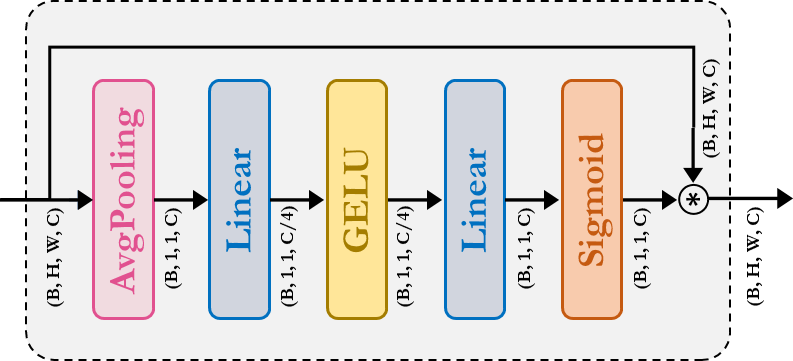
Fused-MBConv:This is similar to the one used in EfficientNetV2. It uses Depthwise-Conv, GELU, SE, Conv, to extract feature with a resiudal connection. Note that, no new module is declared for this one, we simply applied corresponding modules directly.
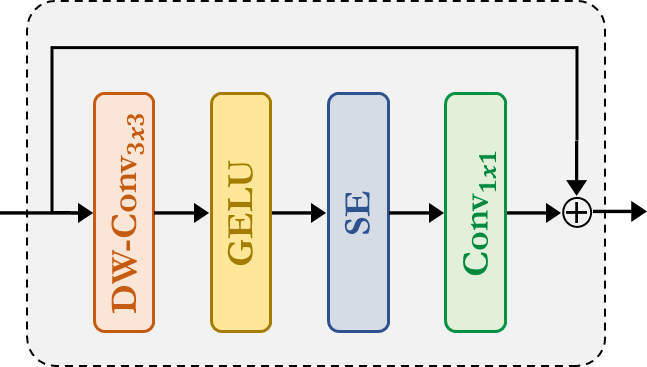
ReduceSize: It is a CNN based downsample module which abvobe mentionedFused-MBConvmodule to extract feature, Strided Conv to simultaneously reduce spatial dimension and increse channelwise dimention of the features and finally LayerNormalization module to normalize features. In the paper/figure this module is referred as downsample module. I think it is mention worthy that SwniTransformer usedPatchMergingmodule instead ofReduceSizeto reduce the spatial dimention and increase channelwise dimension which uses fully-connected/dense/linear module. According to the GCViT paper, one of the purposes of usingReduceSizeis to add inductive bias through CNN module.
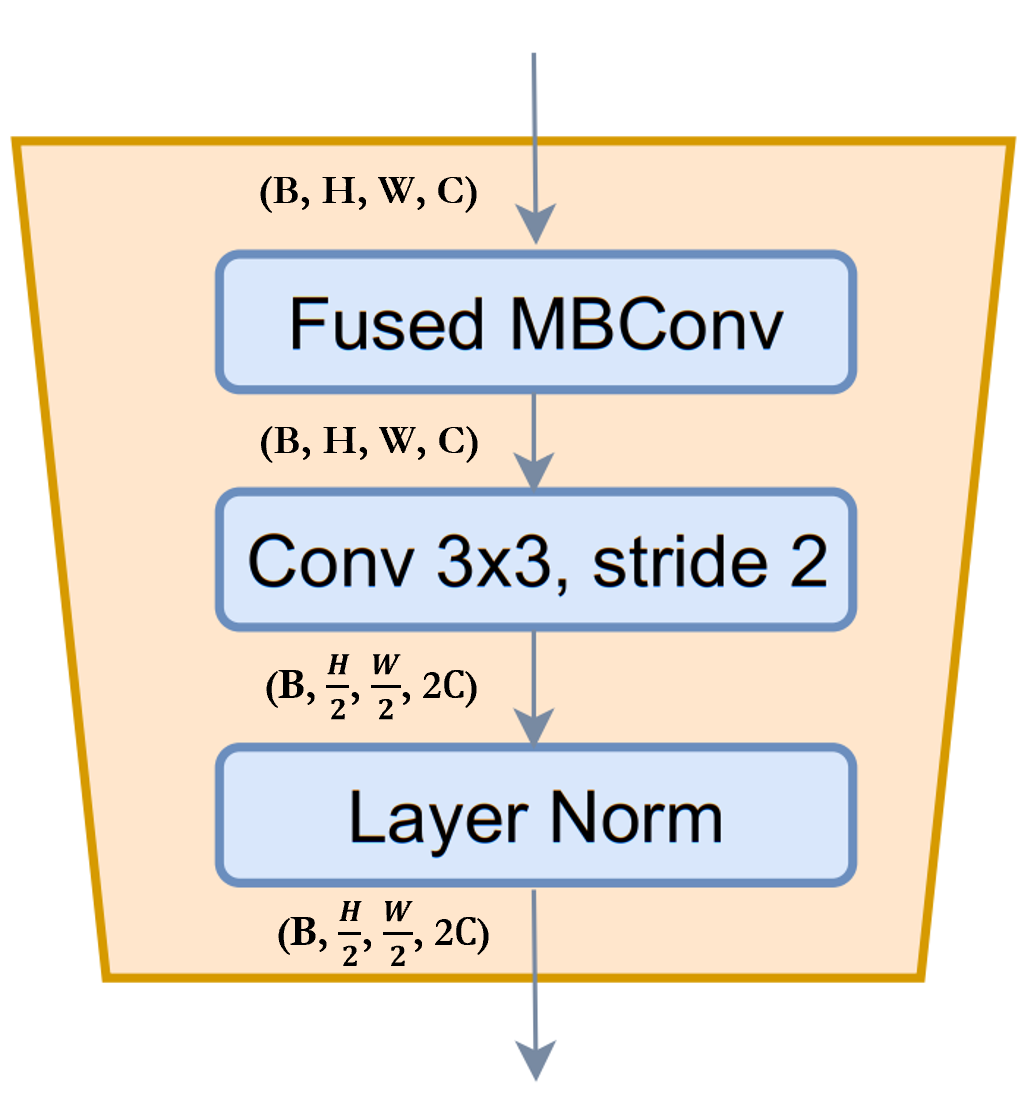
MLP:This is our very own Multi Layer Perceptron module. This a feed-forward/fully-connected/linear module which simply projects input to an arbitary dimension.DropPath/StocasticDepth:This operation is explaied in the figure below from the paper. It reduces the depth of a network during trainings, while keeping it unchanged during testing. This is achieved by randomly deactivating entire ResBlocks during training and bypassing their transformations through skip connections.

Identity: This module is tensorflow ver. of pytorchnn.Identitymodule which simply passes through the input without any modification.
class SE(tf.keras.layers.Layer):
"""
Squeeze and excitation block
"""
def __init__(self, oup=None, expansion=0.25, **kwargs):
"""
Args:
oup: output features dimension, if `None` use same dim as input.
expansion: expansion ratio.
"""
super().__init__(**kwargs)
self.expansion = expansion
self.oup = oup
def build(self, input_shape):
inp = input_shape[-1]
self.oup = self.oup or inp
self.avg_pool = tfa.layers.AdaptiveAveragePooling2D(1, name="avg_pool")
self.fc = [
tf.keras.layers.Dense(
int(inp * self.expansion), use_bias=False, name="fc/0"
),
tf.keras.layers.Activation("gelu", name="fc/1"),
tf.keras.layers.Dense(self.oup, use_bias=False, name="fc/2"),
tf.keras.layers.Activation("sigmoid", name="fc/3"),
]
super().build(input_shape)
def call(self, inputs, **kwargs):
b, _, _, c = tf.unstack(tf.shape(inputs), num=4)
x = tf.reshape(self.avg_pool(inputs), (b, c))
for layer in self.fc:
x = layer(x)
x = tf.reshape(x, (b, 1, 1, c))
return x * inputs
class ReduceSize(tf.keras.layers.Layer):
"""
Down-sampling block based on: "Hatamizadeh et al.,
Global Context Vision Transformers <https://arxiv.org/abs/2206.09959>"
"""
def __init__(self, keep_dim=False, **kwargs):
"""
Args:
keep_dim: if False spatial dim is reduced and channel dim is increased
"""
super().__init__(**kwargs)
self.keep_dim = keep_dim
def build(self, input_shape):
embed_dim = input_shape[-1]
dim_out = embed_dim if self.keep_dim else 2 * embed_dim
self.pad1 = tf.keras.layers.ZeroPadding2D(1, name="pad1")
self.pad2 = tf.keras.layers.ZeroPadding2D(1, name="pad2")
self.conv = [
tf.keras.layers.DepthwiseConv2D(
kernel_size=3, strides=1, padding="valid", use_bias=False, name="conv/0"
),
tf.keras.layers.Activation("gelu", name="conv/1"),
SE(name="conv/2"),
tf.keras.layers.Conv2D(
embed_dim,
kernel_size=1,
strides=1,
padding="valid",
use_bias=False,
name="conv/3",
),
]
self.reduction = tf.keras.layers.Conv2D(
dim_out,
kernel_size=3,
strides=2,
padding="valid",
use_bias=False,
name="reduction",
)
self.norm1 = tf.keras.layers.LayerNormalization(
axis=-1, epsilon=1e-05, name="norm1"
) # eps like PyTorch
self.norm2 = tf.keras.layers.LayerNormalization(
axis=-1, epsilon=1e-05, name="norm2"
)
super().build(input_shape)
def call(self, inputs, **kwargs):
x = self.norm1(inputs)
xr = self.pad1(x)
for layer in self.conv:
xr = layer(xr)
x = x + xr
x = self.pad2(x)
x = self.reduction(x)
x = self.norm2(x)
return x
class Mlp(tf.keras.layers.Layer):
"""
Multi-Layer Perceptron (MLP) block
"""
def __init__(
self,
hidden_features=None,
out_features=None,
act_layer="gelu",
dropout=0.0,
**kwargs
):
"""
Args:
hidden_features: hidden features dimension.
out_features: output features dimension.
act_layer: activation function.
dropout: dropout rate.
"""
super().__init__(**kwargs)
self.hidden_features = hidden_features
self.out_features = out_features
self.act_layer = act_layer
self.dropout = dropout
def build(self, input_shape):
self.in_features = input_shape[-1]
self.hidden_features = self.hidden_features or self.in_features
self.out_features = self.out_features or self.in_features
self.fc1 = tf.keras.layers.Dense(self.hidden_features, name="fc1")
self.act = tf.keras.layers.Activation(self.act_layer, name="act")
self.fc2 = tf.keras.layers.Dense(self.out_features, name="fc2")
self.drop1 = tf.keras.layers.Dropout(self.dropout, name="drop1")
self.drop2 = tf.keras.layers.Dropout(self.dropout, name="drop2")
super().build(input_shape)
def call(self, inputs, **kwargs):
x = self.fc1(inputs)
x = self.act(x)
x = self.drop1(x)
x = self.fc2(x)
x = self.drop2(x)
return x
class DropPath(tf.keras.layers.Layer):
"""DropPath aka Stochastic Depth.
ref: rwightman/pytorch-image-models
"""
def __init__(self, drop_prob=0.0, scale_by_keep=True, **kwargs):
"""
Args:
drop_prob: probability to drop the residual
scale_by_keep: scale the output
"""
super().__init__(**kwargs)
self.drop_prob = drop_prob
self.scale_by_keep = scale_by_keep
def call(self, x, training=None):
if self.drop_prob == 0.0 or not training:
return x
keep_prob = 1 - self.drop_prob
shape = (tf.shape(x)[0],) + (1,) * (len(tf.shape(x)) - 1)
random_tensor = keep_prob + tf.random.uniform(shape, 0, 1)
random_tensor = tf.floor(random_tensor)
if keep_prob > 0.0 and self.scale_by_keep:
x = x / keep_prob
return x * random_tensor
class Identity(tf.keras.layers.Layer):
"""
Pass-through input without any change.
"""
def __init__(self, **kwargs):
super().__init__(**kwargs)
def call(self, x):
return tf.identity(x)
inp = tf.random.uniform(shape=(1, 224, 224, 3))
print("\n## ReduceSize with keep_dim:")
layer = ReduceSize(keep_dim=True)
out = layer(inp)
print('input: ',inp.shape, '\noutput: ',out.shape)
print("\n## ReduceSize with no keep_dim:")
layer = ReduceSize(keep_dim=False)
inp = tf.random.uniform(shape=(1, 224, 224, 3))
out = layer(inp)
print('input: ',inp.shape, '\noutput: ',out.shape)
2022-08-19 05:57:45.075594: I tensorflow/stream_executor/cuda/cuda_gpu_executor.cc:937] successful NUMA node read from SysFS had negative value (-1), but there must be at least one NUMA node, so returning NUMA node zero 2022-08-19 05:57:45.194299: I tensorflow/stream_executor/cuda/cuda_gpu_executor.cc:937] successful NUMA node read from SysFS had negative value (-1), but there must be at least one NUMA node, so returning NUMA node zero 2022-08-19 05:57:45.195096: I tensorflow/stream_executor/cuda/cuda_gpu_executor.cc:937] successful NUMA node read from SysFS had negative value (-1), but there must be at least one NUMA node, so returning NUMA node zero 2022-08-19 05:57:45.202122: I tensorflow/core/platform/cpu_feature_guard.cc:142] This TensorFlow binary is optimized with oneAPI Deep Neural Network Library (oneDNN) to use the following CPU instructions in performance-critical operations: AVX2 AVX512F FMA To enable them in other operations, rebuild TensorFlow with the appropriate compiler flags. 2022-08-19 05:57:45.202509: I tensorflow/stream_executor/cuda/cuda_gpu_executor.cc:937] successful NUMA node read from SysFS had negative value (-1), but there must be at least one NUMA node, so returning NUMA node zero 2022-08-19 05:57:45.203329: I tensorflow/stream_executor/cuda/cuda_gpu_executor.cc:937] successful NUMA node read from SysFS had negative value (-1), but there must be at least one NUMA node, so returning NUMA node zero 2022-08-19 05:57:45.204070: I tensorflow/stream_executor/cuda/cuda_gpu_executor.cc:937] successful NUMA node read from SysFS had negative value (-1), but there must be at least one NUMA node, so returning NUMA node zero 2022-08-19 05:57:47.381084: I tensorflow/stream_executor/cuda/cuda_gpu_executor.cc:937] successful NUMA node read from SysFS had negative value (-1), but there must be at least one NUMA node, so returning NUMA node zero 2022-08-19 05:57:47.381896: I tensorflow/stream_executor/cuda/cuda_gpu_executor.cc:937] successful NUMA node read from SysFS had negative value (-1), but there must be at least one NUMA node, so returning NUMA node zero 2022-08-19 05:57:47.382610: I tensorflow/stream_executor/cuda/cuda_gpu_executor.cc:937] successful NUMA node read from SysFS had negative value (-1), but there must be at least one NUMA node, so returning NUMA node zero 2022-08-19 05:57:47.383233: I tensorflow/core/common_runtime/gpu/gpu_device.cc:1510] Created device /job:localhost/replica:0/task:0/device:GPU:0 with 15403 MB memory: -> device: 0, name: Tesla P100-PCIE-16GB, pci bus id: 0000:00:04.0, compute capability: 6.0
## ReduceSize with keep_dim:
2022-08-19 05:57:49.664485: I tensorflow/stream_executor/cuda/cuda_dnn.cc:369] Loaded cuDNN version 8005
input: (1, 224, 224, 3) output: (1, 112, 112, 3) ## ReduceSize with no keep_dim: input: (1, 224, 224, 3) output: (1, 112, 112, 6)
Model¶
Let's directly jump to the model. As we can see from the call method,
- It creates patch embeddings from an image. This layer doesn't flattens these embeddings which means output of this module will be $(batch, \frac{height}{window\_size}, \frac{width}{window\_size}, embed\_dim)$ instead of $(batch, \frac{height \times width}{window\_size^2}, embed\_dim)$.
- Then it applies
Dropoutmodule which randomly sets input units to 0. - It passes these embeddings to series of
Levelmodules which we are callinglevelwhere,- Global token is generated
- Both local & global attention is applied
- Finally downsample is applied.
- So, output after $n$ number of levels, shape: $(batch, \frac{width}{window\_size \times 2^{n-1}}, \frac{width}{window\_size \times 2^{n-1}}, embed\_dim \times 2^{n-1})$. In the last layer paper doesn't use downsample and increase channels.
- Output of above layer is normalized using
LayerNormalizationmodule. - In the head, 2D features are converted to 1D features with
Poolingmodule. Output shape after this module is $(batch, embed\_dim \times 2^{n-1})$ - Finally, pooled features are sent to
Dense/Linearmodule for classification.
Sumamry: image $\rightarrow$ (patchs + embedding) $\rightarrow$ dropout $\rightarrow$ (attention + feature extraction) $\rightarrow$ normalizaion $\rightarrow$ pooling $\rightarrow$ classify
class GCViT(tf.keras.Model):
"""
GCViT based on: "Hatamizadeh et al.,
Global Context Vision Transformers <https://arxiv.org/abs/2206.09959>"
"""
def __init__(
self,
window_size,
embed_dim,
depths,
num_heads,
drop_rate=0.0,
mlp_ratio=3.0,
qkv_bias=True,
qk_scale=None,
attn_drop=0.0,
path_drop=0.1,
layer_scale=None,
num_classes=1000,
head_act="softmax",
**kwargs,
):
"""
Args:
embed_dim: feature size dimension.
depths: number of layers in each stage.
window_size: window size in each stage.
mlp_ratio: MLP ratio.
num_heads: number of heads in each stage.
path_drop: drop path rate.
num_classes: number of classes.
qkv_bias: bool argument for query, key, value learnable bias.
qk_scale: bool argument to scaling query, key.
drop_rate: dropout rate.
attn_drop: attention dropout rate.
layer_scale: layer scaling coefficient.
"""
super().__init__(**kwargs)
self.window_size = window_size
self.embed_dim = embed_dim
self.depths = depths
self.num_heads = num_heads
self.drop_rate = drop_rate
self.mlp_ratio = mlp_ratio
self.qkv_bias = qkv_bias
self.qk_scale = qk_scale
self.attn_drop = attn_drop
self.path_drop = path_drop
self.layer_scale = layer_scale
self.num_classes = num_classes
self.head_act = head_act
self.patch_embed = PatchEmbed(embed_dim=embed_dim, name="patch_embed")
self.pos_drop = tf.keras.layers.Dropout(drop_rate, name="pos_drop")
path_drops = np.linspace(0.0, path_drop, sum(depths))
keep_dims = [
(False, False, False),
(False, False),
(True,),
(True,),
]
self.levels = []
for i in range(len(depths)):
path_drop = path_drops[sum(depths[:i]) : sum(depths[: i + 1])].tolist()
level = Level(
depth=depths[i],
num_heads=num_heads[i],
window_size=window_size[i],
keep_dims=keep_dims[i],
downsample=(i < len(depths) - 1),
mlp_ratio=mlp_ratio,
qkv_bias=qkv_bias,
qk_scale=qk_scale,
drop=drop_rate,
attn_drop=attn_drop,
path_drop=path_drop,
layer_scale=layer_scale,
name=f"levels/{i}",
)
self.levels.append(level)
self.norm = tf.keras.layers.LayerNormalization(
axis=-1, epsilon=1e-05, name="norm"
)
self.pool = tf.keras.layers.GlobalAveragePooling2D(name="pool")
self.head = tf.keras.layers.Dense(num_classes, name="head", activation=head_act)
def call(self, inputs, **kwargs):
x = self.patch_embed(inputs) # shape: (B, H, W, C)
x = self.pos_drop(x)
x = tf.cast(x, dtype=tf.float32)
for level in self.levels:
x = level(x) # shape: (B, H_, W_, C_)
x = self.norm(x)
x = self.pool(x) # shape: (B, C__)
x = self.head(x)
return x
def build_graph(self, input_shape=(224, 224, 3)):
"""https://www.kaggle.com/code/ipythonx/tf-hybrid-efficientnet-swin-transformer-gradcam"""
x = tf.keras.Input(shape=input_shape)
return tf.keras.Model(inputs=[x], outputs=self.call(x), name=self.name)
def summary(self, input_shape=(224, 224, 3)):
return self.build_graph(input_shape).summary()
config = {
'window_size': (7, 7, 14, 7),
'embed_dim': 64,
'depths': (3, 4, 19, 5),
'num_heads': (2, 4, 8, 16)
}
model = GCViT(**config)
inp = tf.random.uniform((1, 224, 224, 3))
out = model(inp)
model.summary()
Model: "gc_vi_t" _________________________________________________________________ Layer (type) Output Shape Param # ================================================================= input_1 (InputLayer) [(None, 224, 224, 3)] 0 _________________________________________________________________ patch_embed (PatchEmbed) (None, 56, 56, 64) 45632 _________________________________________________________________ pos_drop (Dropout) (None, 56, 56, 64) 0 _________________________________________________________________ tf.cast (TFOpLambda) (None, 56, 56, 64) 0 _________________________________________________________________ levels/0 (Level) (None, 28, 28, 128) 223030 _________________________________________________________________ levels/1 (Level) (None, 14, 14, 256) 1004048 _________________________________________________________________ levels/2 (Level) (None, 7, 7, 512) 13411288 _________________________________________________________________ levels/3 (Level) (None, 7, 7, 512) 13023952 _________________________________________________________________ norm (LayerNormalization) (None, 7, 7, 512) 1024 _________________________________________________________________ pool (GlobalAveragePooling2D (None, 512) 0 _________________________________________________________________ head (Dense) (None, 1000) 513000 ================================================================= Total params: 28,221,974 Trainable params: 28,221,974 Non-trainable params: 0 _________________________________________________________________
Stem¶
Notes: In the code, this module is referred to as PatchEmbed but on paper, it is referred to as Stem.
In the model, we have first used patch_embed module. Let's try to understand this module. As we can see from the call method,
- This module first pads input
- Then uses convolutions to extract patches with embeddings.
- Finally, uses
ReduceSizemodule to first extract features with convolution but neither reduces spatial dimension nor increases spatial dimension. - One important point to notice, unlike ViT or SwinTransformer, GCViT creates overlapping patches. We can notice that from the code,
Conv2D(self.embed_dim, kernel_size=3, strides=2, name='proj'). If we wanted non-overlapping patches then we would've used the samekernel_sizeandstride. - This module reduces the spatial dimension of input by $4x$.
Summary: image $\rightarrow$ padding $\rightarrow$ convolution $\rightarrow$ (feature_extract + downsample)
class PatchEmbed(tf.keras.layers.Layer):
"""
Patch embedding block based on: "Hatamizadeh et al.,
Global Context Vision Transformers <https://arxiv.org/abs/2206.09959>"
"""
def __init__(self, embed_dim, **kwargs):
"""
Args:
embed_dim: feature size dimension.
"""
super().__init__(**kwargs)
self.embed_dim = embed_dim
def build(self, input_shape):
self.pad = tf.keras.layers.ZeroPadding2D(1, name="pad")
self.proj = tf.keras.layers.Conv2D(
self.embed_dim, kernel_size=3, strides=2, name="proj"
)
self.conv_down = ReduceSize(keep_dim=True, name="conv_down")
super().build(input_shape)
def call(self, inputs, **kwargs):
x = self.pad(inputs)
x = self.proj(x)
x = self.conv_down(x)
return x
layer = PatchEmbed(embed_dim=64)
inp = tf.random.uniform(shape=(1, 224, 224, 3))
out = layer(inp)
print('input: ',inp.shape, '\noutput: ',out.shape)
input: (1, 224, 224, 3) output: (1, 56, 56, 64)
Level¶
Note: This module has both Transformer and CNN modules.
In the model, the second module that we have used is level. Let's try to understand this module. As we can see from the call method,
- First it creates global_token with a series of
FeatExtractmodules. As we'll see later thatFeatExtractis nothing but a simple CNN based module. - Then it uses series of
Blockmodules to apply local or global window attention depending on depth level. - Finally, it uses
ReduceSizeto reduce the dimension of contextualized features.
Summary: feature_map $\rightarrow$ global_token $\rightarrow$ local/global window attention $\rightarrow$ dowsample

class Level(tf.keras.layers.Layer):
"""
GCViT level based on: "Hatamizadeh et al.,
Global Context Vision Transformers <https://arxiv.org/abs/2206.09959>"
"""
def __init__(
self,
depth,
num_heads,
window_size,
keep_dims,
downsample=True,
mlp_ratio=4.0,
qkv_bias=True,
qk_scale=None,
drop=0.0,
attn_drop=0.0,
path_drop=0.0,
layer_scale=None,
**kwargs,
):
"""
Args:
depth: number of layers in each stage.
input_resolution: input image resolution.
window_size: window size in each stage.
downsample: bool argument for down-sampling.
mlp_ratio: MLP ratio.
num_heads: number of heads in each stage.
qkv_bias: bool argument for query, key, value learnable bias.
qk_scale: bool argument to scaling query, key.
drop: dropout rate.
attn_drop: attention dropout rate.
drop_path: drop path rate.
norm_layer: normalization layer.
layer_scale: layer scaling coefficient.
"""
super().__init__(**kwargs)
self.depth = depth
self.num_heads = num_heads
self.window_size = window_size
self.keep_dims = keep_dims
self.downsample = downsample
self.mlp_ratio = mlp_ratio
self.qkv_bias = qkv_bias
self.qk_scale = qk_scale
self.drop = drop
self.attn_drop = attn_drop
self.path_drop = path_drop
self.layer_scale = layer_scale
def build(self, input_shape):
path_drop = (
[self.path_drop] * self.depth
if not isinstance(self.path_drop, list)
else self.path_drop
)
self.blocks = [
Block(
window_size=self.window_size,
num_heads=self.num_heads,
global_query=bool(i % 2),
mlp_ratio=self.mlp_ratio,
qkv_bias=self.qkv_bias,
qk_scale=self.qk_scale,
drop=self.drop,
attn_drop=self.attn_drop,
path_drop=path_drop[i],
layer_scale=self.layer_scale,
name=f"blocks/{i}",
)
for i in range(self.depth)
]
self.down = ReduceSize(keep_dim=False, name="downsample")
self.q_global_gen = GlobalQueryGen(self.keep_dims, name="q_global_gen")
super().build(input_shape)
def call(self, inputs, **kwargs):
H, W = tf.unstack(tf.shape(inputs)[1:3], num=2)
x = inputs
q_global = self.q_global_gen(x) # shape: (B, win_size, win_size, C)
for i, blk in enumerate(self.blocks):
if i % 2:
x = blk([x, q_global]) # shape: (B, H, W, C)
else:
x = blk([x]) # shape: (B, H, W, C)
if self.downsample:
x = self.down(x) # shape: (B, H//2, W//2, 2*C)
return x
print("## Level with no downsample:")
layer = Level(depth=3, num_heads=2, window_size=7, keep_dims=[False, False, False], downsample=True)
inp = tf.random.uniform(shape=(1, 56, 56, 64))
out = layer(inp)
print('input: ',inp.shape, '\noutput: ',out.shape)
print("\n## Level with downsample:")
layer = Level(depth=3, num_heads=2, window_size=7, keep_dims=[False, False, False], downsample=False)
inp = tf.random.uniform(shape=(1, 56, 56, 64))
out = layer(inp)
print('input: ',inp.shape, '\noutput: ',out.shape)
## Level with no downsample: input: (1, 56, 56, 64) output: (1, 28, 28, 128) ## Level with downsample: input: (1, 56, 56, 64) output: (1, 56, 56, 64)
Global Token Gen.¶
Notes: It is one of the two CNN modules that is used to imppose inductive bias.
As we can see from above cell, in the level we have first used to_q_global/Global Token Gen./FeatExtract. Let's try to understand how it works,
- This module is series of
FeatureExtractmodule, according to paper we need to repeat this module $K$ times, where $$K = \log_{2}(\frac{H}{h})$$ $$H = feature\_map\_height$$ $$W = feature\_map\_width$$ FeatExtract:This layer is very similar toReduceSizemodule except it uses MaxPooling module to reduce the dimension, it doesn't increse feature dimension (channelsie) and it doesn't uses LayerNormalizaton. This module is used to inGenerate Token Gen.module repeatedly to generte global tokens for global-context-attention.- One important point to notice from the figure is that, global tokens is shared across the whole image which means we use only one global window for all local tokens in a image. This makes the computation very efficient.
- For input feature map with shape $(B, H, W, C)$, we'll get output shape $(B, h, w, C)$. If we copy these global tokens for total $M$ local windows in a image where, $M = \frac{H \times W}{h \times w} = num\_window$, then output shape: $(B * M, h, w, C)$.
Summary: This module is used to
resizethe image to fit window.
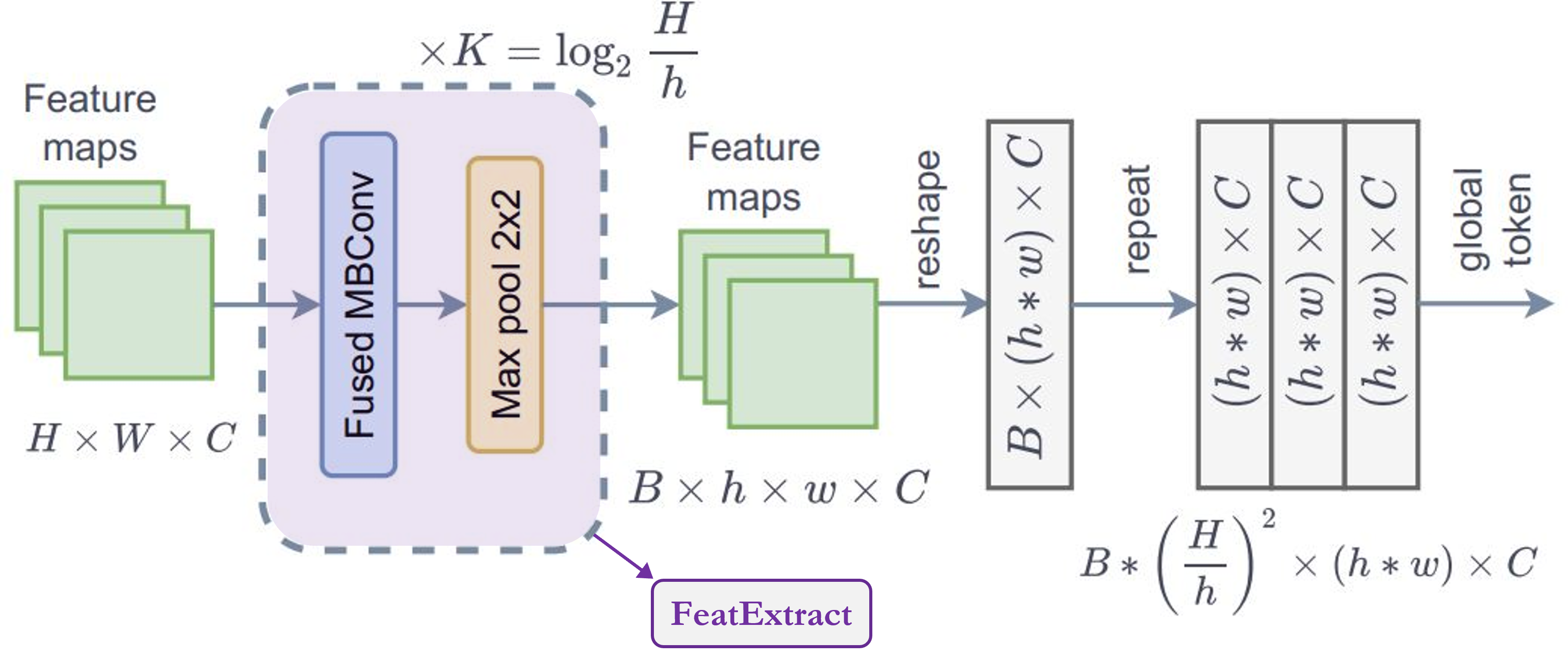
class FeatExtract(tf.keras.layers.Layer):
"""
Feature extraction block based on: "Hatamizadeh et al.,
Global Context Vision Transformers <https://arxiv.org/abs/2206.09959>"
"""
def __init__(self, keep_dim=False, **kwargs):
"""
Args:
keep_dim: bool argument for maintaining the resolution.
"""
super().__init__(**kwargs)
self.keep_dim = keep_dim
def build(self, input_shape):
embed_dim = input_shape[-1]
self.pad1 = tf.keras.layers.ZeroPadding2D(1, name="pad1")
self.pad2 = tf.keras.layers.ZeroPadding2D(1, name="pad2")
self.conv = [
tf.keras.layers.DepthwiseConv2D(
kernel_size=3, strides=1, padding="valid", use_bias=False, name="conv/0"
),
tf.keras.layers.Activation("gelu", name="conv/1"),
SE(name="conv/2"),
tf.keras.layers.Conv2D(
embed_dim,
kernel_size=1,
strides=1,
padding="valid",
use_bias=False,
name="conv/3",
),
]
if not self.keep_dim:
self.pool = tf.keras.layers.MaxPool2D(
pool_size=3, strides=2, padding="valid", name="pool"
)
super().build(input_shape)
def call(self, inputs, **kwargs):
x = inputs
xr = self.pad1(x)
for layer in self.conv:
xr = layer(xr)
x = x + xr # if pad had weights it would've thrown error with .save_weights()
if not self.keep_dim:
x = self.pad2(x)
x = self.pool(x)
return x
class GlobalQueryGen(tf.keras.layers.Layer):
"""
Global query generator based on: "Hatamizadeh et al.,
Global Context Vision Transformers <https://arxiv.org/abs/2206.09959>"
"""
def __init__(self, keep_dims=False, **kwargs):
"""
Args:
keep_dims: to keep the dimension of FeatExtract layer.
For instance, repeating log(56/7) = 3 blocks, with input window dimension 56 and output window dimension 7 at
down-sampling ratio 2. Please check Fig.5 of GC ViT paper for details.
"""
super().__init__(**kwargs)
self.keep_dims = keep_dims
def build(self, input_shape):
self.to_q_global = [
FeatExtract(keep_dim, name=f"to_q_global/{i}")
for i, keep_dim in enumerate(self.keep_dims)
]
super().build(input_shape)
def call(self, inputs, **kwargs):
x = inputs
for layer in self.to_q_global:
x = layer(x)
return x
print("## GlobalQueryGen:")
layer = GlobalQueryGen(keep_dims = [False, False, False])
inp = tf.random.uniform(shape=(1, 56, 56, 64))
out = layer(inp)
print('input: ',inp.shape, '\noutput: ',out.shape)
## GlobalQueryGen: input: (1, 56, 56, 64) output: (1, 7, 7, 64)
Block¶
Notes: This module doesn't have any Convolutional module.
In the level second module that we have used is block. Let's try to understand how it works. As we can see from the call method,
Blockmodule takes either only feature_maps for local attention or additional global query for global attention.- Before sending feature maps for attention, this module converts batch feature maps to batch windows as we'll be applying Window Attention.
- Then we send batch batch windows for attention.
- After attention has been applied we revert batch windows to batch feature maps.
- Before sending the attention to applied features for output, this module applies Stochastic Depth regularization in the residual connection. Also, before applying Stochastic Depth it rescales the input with trainable parameters. Note that, this Stochastic Depth block hasn't been shown in the figure of the paper.
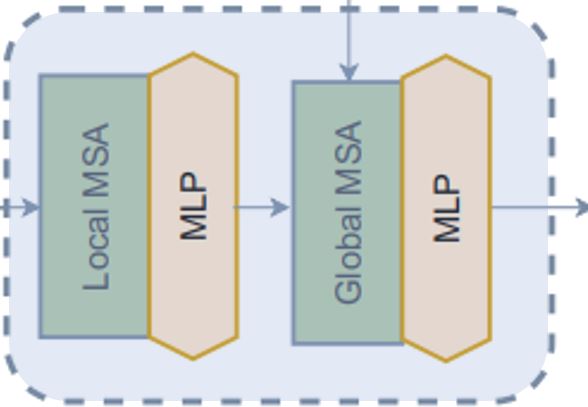
class Block(tf.keras.layers.Layer):
"""
GCViT block based on: "Hatamizadeh et al.,
Global Context Vision Transformers <https://arxiv.org/abs/2206.09959>"
"""
def __init__(
self,
window_size,
num_heads,
global_query,
mlp_ratio=4.0,
qkv_bias=True,
qk_scale=None,
drop=0.0,
attn_drop=0.0,
path_drop=0.0,
act_layer="gelu",
layer_scale=None,
**kwargs
):
"""
Args:
num_heads: number of attention head.
window_size: window size.
global_query: apply global window attention
mlp_ratio: MLP ratio.
qkv_bias: bool argument for query, key, value learnable bias.
qk_scale: bool argument to scaling query, key.
drop: dropout rate.
attn_drop: attention dropout rate.
path_drop: drop path rate.
act_layer: activation function.
layer_scale: layer scaling coefficient.
"""
super().__init__(**kwargs)
self.window_size = window_size
self.num_heads = num_heads
self.global_query = global_query
self.mlp_ratio = mlp_ratio
self.qkv_bias = qkv_bias
self.qk_scale = qk_scale
self.drop = drop
self.attn_drop = attn_drop
self.path_drop = path_drop
self.act_layer = act_layer
self.layer_scale = layer_scale
def build(self, input_shape):
B, H, W, C = input_shape[0]
self.norm1 = tf.keras.layers.LayerNormalization(
axis=-1, epsilon=1e-05, name="norm1"
)
self.attn = WindowAttention(
window_size=self.window_size,
num_heads=self.num_heads,
global_query=self.global_query,
qkv_bias=self.qkv_bias,
qk_scale=self.qk_scale,
attn_dropout=self.attn_drop,
proj_dropout=self.drop,
name="attn",
)
self.drop_path1 = DropPath(self.path_drop)
self.drop_path2 = DropPath(self.path_drop)
self.norm2 = tf.keras.layers.LayerNormalization(
axis=-1, epsilon=1e-05, name="norm2"
)
self.mlp = Mlp(
hidden_features=int(C * self.mlp_ratio),
dropout=self.drop,
act_layer=self.act_layer,
name="mlp",
)
if self.layer_scale is not None:
self.gamma1 = self.add_weight(
"gamma1",
shape=[C],
initializer=tf.keras.initializers.Constant(self.layer_scale),
trainable=True,
dtype=self.dtype,
)
self.gamma2 = self.add_weight(
"gamma2",
shape=[C],
initializer=tf.keras.initializers.Constant(self.layer_scale),
trainable=True,
dtype=self.dtype,
)
else:
self.gamma1 = 1.0
self.gamma2 = 1.0
self.num_windows = int(H // self.window_size) * int(W // self.window_size)
super().build(input_shape)
def call(self, inputs, **kwargs):
if self.global_query:
inputs, q_global = inputs
else:
inputs = inputs[0]
B, H, W, C = tf.unstack(tf.shape(inputs), num=4)
x = self.norm1(inputs)
# create windows and concat them in batch axis
x = window_partition(x, self.window_size) # (B_, win_h, win_w, C)
# flatten patch
x = tf.reshape(
x, shape=[-1, self.window_size * self.window_size, C]
) # (B_, N, C) => (batch*num_win, num_token, feature)
# attention
if self.global_query:
x = self.attn([x, q_global])
else:
x = self.attn([x])
# reverse window partition
x = window_reverse(x, self.window_size, H, W, C)
# FFN
x = inputs + self.drop_path1(x * self.gamma1)
x = x + self.drop_path2(self.gamma2 * self.mlp(self.norm2(x)))
return x
# Global
print("## Local WindowAttention :")
layer = Block(window_size=7, num_heads=2, global_query=False)
inp = tf.random.uniform(shape=(1, 56, 56, 64))
print('input: ',inp.shape)
out = layer([inp])
print('output: ', out.shape)
# Local
print("\n## Global WindowAttention :")
layer = Block(window_size=7, num_heads=2, global_query=False)
inp = tf.random.uniform(shape=(1, 56, 56, 64))
print('input: ',inp.shape)
out_fe = inp
for keep_dim in [False]*3:
out_fe = FeatExtract(keep_dim)(out_fe)
print("<global-tokens>: ", out_fe.shape)
out = layer([out, out_fe])
print('output: ', out.shape)
## Local WindowAttention : input: (1, 56, 56, 64) output: (1, 56, 56, 64) ## Global WindowAttention : input: (1, 56, 56, 64) <global-tokens>: (1, 7, 7, 64) output: (1, 56, 56, 64)
Window¶
In the block module, we have created windows before and after applying attention. Let's try to understand how we're creating windows,
- Following module converts feature maps $(B, H, W, C)$ to stacked windows $(B \times \frac{H}{h} \times \frac{W}{w}, h, w, C)$ => $(num\_windows_{batch}, window\_size, window\_size, channel)$
- This module uses
reshape&transposeto create these windows out of image instead of iterating over them.
def window_partition(x, window_size):
"""
Args:
x: (B, H, W, C)
window_size: window size
Returns:
local window features (num_windows*B, window_size, window_size, C)
"""
B, H, W, C = tf.unstack(tf.shape(x), num=4)
x = tf.reshape(
x, shape=[-1, H // window_size, window_size, W // window_size, window_size, C]
)
x = tf.transpose(x, perm=[0, 1, 3, 2, 4, 5])
windows = tf.reshape(x, shape=[-1, window_size, window_size, C])
return windows
def window_reverse(windows, window_size, H, W, C):
"""
Args:
windows: local window features (num_windows*B, window_size, window_size, C)
window_size: Window size
H: Height of image
W: Width of image
C: Channel of image
Returns:
x: (B, H, W, C)
"""
x = tf.reshape(
windows,
shape=[-1, H // window_size, W // window_size, window_size, window_size, C],
)
x = tf.transpose(x, perm=[0, 1, 3, 2, 4, 5])
x = tf.reshape(x, shape=[-1, H, W, C])
return x
inp = tf.random.uniform(shape=(1, 56, 56, 64))
print("## Window :")
out = window_partition(inp, window_size=7)
print('input: ',inp.shape)
print("after-window: ",out.shape)
out = window_reverse(out, window_size=7, H=56, W=56, C=64)
print("after-window-reverse: ",out.shape)
## Window : input: (1, 56, 56, 64) after-window: (64, 7, 7, 64) after-window-reverse: (1, 56, 56, 64)
Attention¶
Notes: This is the core contribution of the paper.
As we can see from the call method,
WindowAttentionmodule applies both local and global window attention depending onglobal_queryparameter.- First it converts input features into
query, key, valuefor local attention andkey, valuefor global attention. For global attention, it takes global query fromGlobal Token Gen.. One thing to notice from the code is that we divide the features or embed_dim among all the heads of Transformer to reduce the computation.qkv = tf.reshape(qkv, [B_, N, self.qkv_size, self.num_heads, C // self.num_heads]) - Before sending query, key and value for attention, global token goes through an important process. Same global tokens or one global window gets copied for all the local windows to increase efficiency.
q_global = tf.repeat(q_global, repeats=B_//B, axis=0), hereB_//Bmeansnum_windowsin a image. - Then simply applies
local-window-self-attentionorglobal-window-attentiondepending onglobal_queryparameter. One thing to notice from the code is that we are adding relative-positional-embedding with the attention mask instead of the patch embedding.attn = attn + relative_position_bias[tf.newaxis,]

- Now, let's think for a bit and try to understand what is happening here. Let's focus on the figure below. We can see from the left, that in the local-attention the query is local and it's limited to the local window (red square border) hence we don't have access to long-range information. But on the right that due to global query we're now not limited to local-windows (blue square border) and we have access to long-range information.
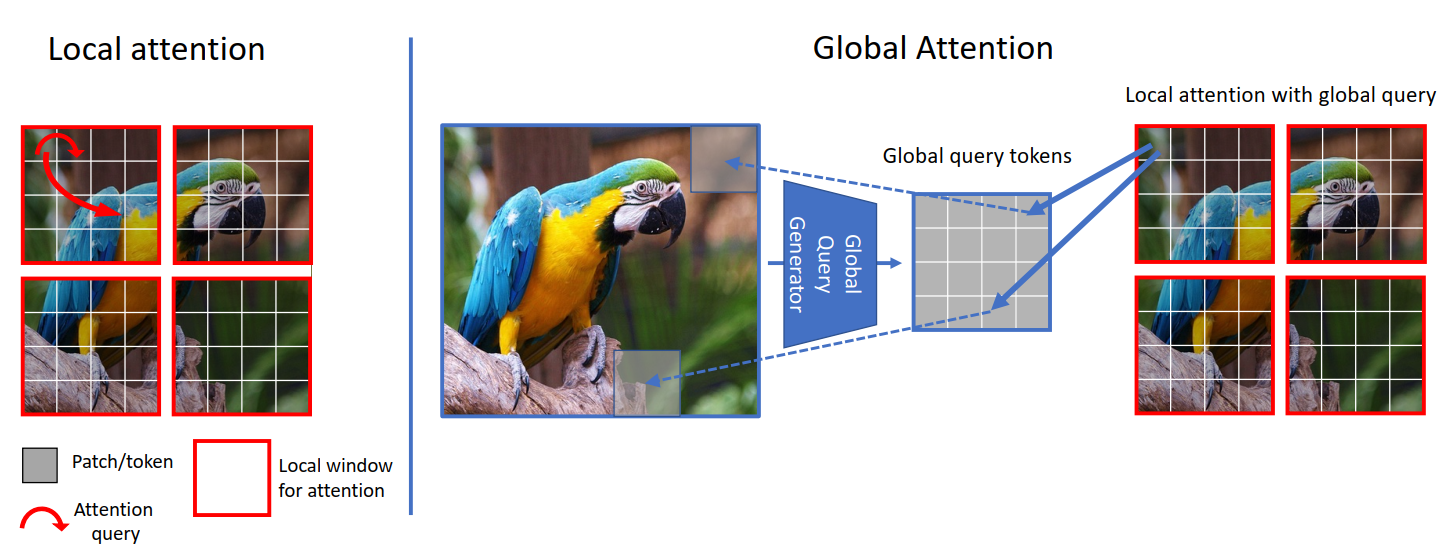
- In ViT we compare (attention) image-tokens with image-tokens, in SwinTransformer we compare window-tokens with window-tokens but in GCViT we compare image-tokens with window-tokens. But now you may ask, how can compare(attention) image-tokens with window-tokens even after image-tokens have larger dimensions than window-tokens? (from above figure image-tokens have shape $(1, 8, 8, 3)$ and window-tokens have shape $(1, 4, 4, 3)$). Yes, you are right we can't directly compare them hence we resize image-tokens to fit window-tokens with
Global Token Gen./FeatExtractCNN module. The following table should give you a clear comparison,
| Model | Query Tokens | Key-Value Tokens | Attention Type | Attention Coverage |
|---|---|---|---|---|
| ViT | image | image | self-attention | global |
| SwinTransformer | window | window | self-attention | local |
| GCViT | resized-image | window | image-window attention | global |
class WindowAttention(tf.keras.layers.Layer):
"""
Local window attention based on: "Liu et al.,
Swin Transformer: Hierarchical Vision Transformer using Shifted Windows
<https://arxiv.org/abs/2103.14030>"
"""
def __init__(
self,
window_size,
num_heads,
global_query,
qkv_bias=True,
qk_scale=None,
attn_dropout=0.0,
proj_dropout=0.0,
**kwargs
):
"""
Args:
num_heads: number of attention head.
window_size: window size.
global_query: if the input contains global_query
qkv_bias: bool argument for query, key, value learnable bias.
qk_scale: bool argument to scaling query, key.
attn_dropout: attention dropout rate.
proj_dropout: output dropout rate.
"""
super().__init__(**kwargs)
window_size = (window_size, window_size)
self.window_size = window_size
self.num_heads = num_heads
self.global_query = global_query
self.qkv_bias = qkv_bias
self.qk_scale = qk_scale
self.attn_dropout = attn_dropout
self.proj_dropout = proj_dropout
def build(self, input_shape):
embed_dim = input_shape[0][-1]
head_dim = embed_dim // self.num_heads
self.scale = self.qk_scale or head_dim**-0.5
self.qkv_size = 3 - int(self.global_query)
self.qkv = tf.keras.layers.Dense(
embed_dim * self.qkv_size, use_bias=self.qkv_bias, name="qkv"
)
self.relative_position_bias_table = self.add_weight(
"relative_position_bias_table",
shape=[
(2 * self.window_size[0] - 1) * (2 * self.window_size[1] - 1),
self.num_heads,
],
initializer=tf.keras.initializers.TruncatedNormal(stddev=0.02),
trainable=True,
dtype=self.dtype,
)
self.attn_drop = tf.keras.layers.Dropout(self.attn_dropout, name="attn_drop")
self.proj = tf.keras.layers.Dense(embed_dim, name="proj")
self.proj_drop = tf.keras.layers.Dropout(self.proj_dropout, name="proj_drop")
self.softmax = tf.keras.layers.Activation("softmax", name="softmax")
self.relative_position_index = self.get_relative_position_index()
super().build(input_shape)
def get_relative_position_index(self):
coords_h = tf.range(self.window_size[0])
coords_w = tf.range(self.window_size[1])
coords = tf.stack(tf.meshgrid(coords_h, coords_w, indexing="ij"), axis=0)
coords_flatten = tf.reshape(coords, [2, -1])
relative_coords = coords_flatten[:, :, None] - coords_flatten[:, None, :]
relative_coords = tf.transpose(relative_coords, perm=[1, 2, 0])
relative_coords_xx = relative_coords[:, :, 0] + self.window_size[0] - 1
relative_coords_yy = relative_coords[:, :, 1] + self.window_size[1] - 1
relative_coords_xx = relative_coords_xx * (2 * self.window_size[1] - 1)
relative_position_index = relative_coords_xx + relative_coords_yy
return relative_position_index
def call(self, inputs, **kwargs):
if self.global_query:
inputs, q_global = inputs
B = tf.shape(q_global)[0] # B, N, C
else:
inputs = inputs[0]
B_, N, C = tf.unstack(
tf.shape(inputs), num=3
) # B*num_window, num_tokens, channels
qkv = self.qkv(inputs)
qkv = tf.reshape(
qkv, [B_, N, self.qkv_size, self.num_heads, C // self.num_heads]
)
qkv = tf.transpose(qkv, [2, 0, 3, 1, 4])
if self.global_query:
k, v = tf.unstack(
qkv, num=2, axis=0
) # for unknown shame num=None will throw error
q_global = tf.repeat(
q_global, repeats=B_ // B, axis=0
) # num_windows = B_//B => q_global same for all windows in a img
q = tf.reshape(q_global, shape=[B_, N, self.num_heads, C // self.num_heads])
q = tf.transpose(q, perm=[0, 2, 1, 3])
else:
q, k, v = tf.unstack(qkv, num=3, axis=0)
q = q * self.scale
attn = q @ tf.transpose(k, perm=[0, 1, 3, 2])
relative_position_bias = tf.gather(
self.relative_position_bias_table,
tf.reshape(self.relative_position_index, shape=[-1]),
)
relative_position_bias = tf.reshape(
relative_position_bias,
shape=[
self.window_size[0] * self.window_size[1],
self.window_size[0] * self.window_size[1],
-1,
],
)
relative_position_bias = tf.transpose(relative_position_bias, perm=[2, 0, 1])
attn = (
attn
+ relative_position_bias[
tf.newaxis,
]
)
attn = self.softmax(attn)
attn = self.attn_drop(attn)
x = tf.transpose(
(attn @ v), perm=[0, 2, 1, 3]
) # B_, num_tokens, num_heads, channels_per_head
x = tf.reshape(x, shape=[B_, N, C])
x = self.proj(x)
x = self.proj_drop(x)
return x
# Local
print("## Local WindowAttention :")
layer = WindowAttention(window_size=7, num_heads=2, global_query=False)
inp = tf.random.uniform(shape=(1, 56, 56, 64))
out = window_partition(inp, 7)
print('input: ',inp.shape)
print("after-window: ",out.shape)
out = tf.reshape(out, shape=[-1, 7*7, 64])
print("after-reshape: ", out.shape)
out = layer([out])
print('after-attention: ', out.shape)
out = tf.reshape(out, shape=[-1, 7, 7, 64])
print("after-reshape-reverse:", out.shape)
out = window_reverse(out, window_size=7, H=56, W=56, C=64)
print("after-window-reverse", out.shape); print()
# Global
print("## Global WindowAttention :")
layer = WindowAttention(window_size=7, num_heads=2, global_query=True)
inp = tf.random.uniform(shape=(1, 56, 56, 64))
print('input: ',inp.shape)
out_fe = inp
for keep_dim in [False]*3:
out_fe = FeatExtract(keep_dim)(out_fe)
print("<global-tokens>: ", out_fe.shape)
out = window_partition(inp, 7)
print("after-window: ",out.shape)
out = tf.reshape(out, shape=[-1, 7*7, 64])
print("after-reshape: ", out.shape)
out = layer([out, out_fe])
print('after-attention: ', out.shape)
out = tf.reshape(out, shape=[-1, 7, 7, 64])
print("after-reshape-reverse:", out.shape)
out = window_reverse(out, window_size=7, H=56, W=56, C=64)
print("after-window-reverse", out.shape)
## Local WindowAttention : input: (1, 56, 56, 64) after-window: (64, 7, 7, 64) after-reshape: (64, 49, 64) after-attention: (64, 49, 64) after-reshape-reverse: (64, 7, 7, 64) after-window-reverse (1, 56, 56, 64) ## Global WindowAttention : input: (1, 56, 56, 64) <global-tokens>: (1, 7, 7, 64) after-window: (64, 7, 7, 64) after-reshape: (64, 49, 64) after-attention: (64, 49, 64) after-reshape-reverse: (64, 7, 7, 64) after-window-reverse (1, 56, 56, 64)
4. Build Model¶
- Let's build a complete model with all the modules that we've explained above. We'll build GCViT-Tiny model with the configuration mentioned in the paper.
- Also we'll load the ported official pre-trained weights and try for some predictions.
# Model Configs
config = {
'window_size': (7, 7, 14, 7),
'embed_dim': 64,
'depths': (3, 4, 19, 5),
'num_heads': (2, 4, 8, 16)
}
ckpt_link = "https://github.com/awsaf49/gcvit-tf/releases/download/v1.0.9/gcvit_tiny_weights.h5"
# Build Model
model = GCViT(**config)
inp = tf.random.uniform((1, 224, 224, 3))
model(inp)
# Load Weights
ckpt_path = tf.keras.utils.get_file(ckpt_link.split('/')[-1], ckpt_link)
model.load_weights(ckpt_path)
Downloading data from https://github.com/awsaf49/gcvit-tf/releases/download/v1.0.9/gcvit_tiny_weights.h5 113500160/113498376 [==============================] - 3s 0us/step 113508352/113498376 [==============================] - 3s 0us/step
Check Prediction¶
from skimage.data import chelsea
img = tf.keras.applications.imagenet_utils.preprocess_input(chelsea(), mode='torch') # Chelsea the cat
img = tf.image.resize(img, (224, 224))[None,] # resize & create batch
pred = model(img).numpy()
pred_dec = tf.keras.applications.imagenet_utils.decode_predictions(pred)[0]
print("\n# Image:")
plt.figure(figsize=(6,6))
plt.imshow(chelsea())
plt.show()
print()
print("# Prediction:")
for i in range(5):
print("{:<12} : {:0.2f}".format(pred_dec[i][1], pred_dec[i][2]))
Downloading data from https://storage.googleapis.com/download.tensorflow.org/data/imagenet_class_index.json 40960/35363 [==================================] - 0s 0us/step 49152/35363 [=========================================] - 0s 0us/step # Image:
# Prediction: Egyptian_cat : 0.74 tabby : 0.08 tiger_cat : 0.07 lynx : 0.00 radiator : 0.00
5. Reproducibility¶
- Recently, the official codebase has been updated (27 July 2022). Previously, it had some issues which resulted in a performance drop. Even after the update, the code has some issues which may result in a performance drop. Our code above already resolves those issues so no worries (those issues won't be explained here). As resolving these issues creates slight change in the architecture, official weights show different results from the paper.
- In this section we'll try to re-evaluate the model on ImageNetV2 dataset.
import tensorflow as tf
import tensorflow_datasets as tfds
def preprocess_input(example):
image = tf.image.resize(example['image'], (224, 224), method='bicubic')
image = tf.keras.applications.imagenet_utils.preprocess_input(image, mode='torch')
return image, example['label']
# Load dataset
imagenet2 = tfds.load('imagenet_v2', split='test', shuffle_files=True)
imagenet2 = imagenet2.map(preprocess_input, num_parallel_calls=tf.data.AUTOTUNE)
imagenet2 = imagenet2.batch(32)
# Compile Model for eval
model.compile('sgd', 'sparse_categorical_crossentropy', ['accuracy', 'sparse_top_k_categorical_accuracy'])
result = model.evaluate(imagenet2)
print("\n# Result:")
print("Acc@1: {:0.3f} | Acc@5: {:0.3f}".format(result[1], result[2]))
2022-08-19 05:58:10.520498: W tensorflow/core/platform/cloud/google_auth_provider.cc:184] All attempts to get a Google authentication bearer token failed, returning an empty token. Retrieving token from files failed with "Not found: Could not locate the credentials file.". Retrieving token from GCE failed with "Failed precondition: Error executing an HTTP request: libcurl code 6 meaning 'Couldn't resolve host name', error details: Could not resolve host: metadata".
Downloading and preparing dataset 1.18 GiB (download: 1.18 GiB, generated: 1.16 GiB, total: 2.34 GiB) to /root/tensorflow_datasets/imagenet_v2/matched-frequency/3.0.0...
Dataset imagenet_v2 downloaded and prepared to /root/tensorflow_datasets/imagenet_v2/matched-frequency/3.0.0. Subsequent calls will reuse this data.
2022-08-19 05:59:15.455606: I tensorflow/compiler/mlir/mlir_graph_optimization_pass.cc:185] None of the MLIR Optimization Passes are enabled (registered 2)
313/313 [==============================] - 102s 273ms/step - loss: 1.3388 - accuracy: 0.7076 - sparse_top_k_categorical_accuracy: 0.8988 # Result: Acc@1: 0.708 | Acc@5: 0.899
6. Reusability¶
- To reuse the above codes for other tasks, I've created an open-source library (gcvit) with some additional features. Instead of copy-pasting the above codes, we can load the models with just a few lines of code.
- In this section, we'll be also looking into some cool features of this library such as
forward_features,forward_head,reset_classifier(they are inspired by timm library).
# Install Library
!pip install -q gcvit --no-deps
# Load model with pretrained weights
from gcvit import GCViTTiny
model = GCViTTiny(pretrain=True)
# Prediction
pred = model(img)
print("prediction: ", pred.shape)
# Feature Extraction 1D
model.reset_classifier(num_classes=0, head_act=None)
feature = model(img)
print("1D feature: ",feature.shape)
# Feature Extraction 2D
feature = model.forward_features(img)
print("2D feature: ",feature.shape)
WARNING: Running pip as the 'root' user can result in broken permissions and conflicting behaviour with the system package manager. It is recommended to use a virtual environment instead: https://pip.pypa.io/warnings/venv prediction: (1, 1000) 1D feature: (1, 512) 2D feature: (1, 7, 7, 512)
7. Flower Classification¶
Let's train GCViT on Flower Classification Dataset and see how well does it do. We'll also observe Grad-CAM visualization to check what exactly GCViT is looking into for making decision.
Select Device¶
try: # detect TPUs
tpu = tf.distribute.cluster_resolver.TPUClusterResolver.connect() # TPU detection
strategy = tf.distribute.TPUStrategy(tpu)
except ValueError: # detect GPUss
tpu = None
strategy = (
tf.distribute.get_strategy()
) # default strategy that works on CPU and single GPU
print("Number of Accelerators: ", strategy.num_replicas_in_sync)
Number of Accelerators: 1
Configuration¶
# Model
IMAGE_SIZE = [224, 224]
# TPU
if tpu:
BATCH_SIZE = (
16 * strategy.num_replicas_in_sync
) # a TPU has 8 cores so this will be 128
else:
BATCH_SIZE = 32 # on Colab/GPU, a higher batch size may throw(OOM)
# Dataset
CLASSES = [
"dandelion",
"daisy",
"tulips",
"sunflowers",
"roses",
] # don't change the order
# Other constants
MEAN = tf.constant([0.485 * 255, 0.456 * 255, 0.406 * 255]) # imagenet mean
STD = tf.constant([0.229 * 255, 0.224 * 255, 0.225 * 255]) # imagenet std
AUTO = tf.data.AUTOTUNE
Data Pipeline¶
def make_dataset(dataset: tf.data.Dataset, train: bool, image_size: int = IMAGE_SIZE):
def preprocess(image, label):
# for training, do augmentation
if train:
if tf.random.uniform(shape=[]) > 0.5:
image = tf.image.flip_left_right(image)
image = tf.image.resize(image, size=image_size, method="bicubic")
image = (image - MEAN) / STD # normalization
return image, label
if train:
dataset = dataset.shuffle(BATCH_SIZE * 10)
return dataset.map(preprocess, AUTO).batch(BATCH_SIZE, drop_remainder=True).prefetch(AUTO)
Flower Dataset¶
train_dataset, val_dataset = tfds.load(
"tf_flowers",
split=["train[:90%]", "train[90%:]"],
as_supervised=True,
try_gcs=True, # gcs_path is necessary for tpu,
)
num_train = tf.data.experimental.cardinality(train_dataset)
num_val = tf.data.experimental.cardinality(val_dataset)
print(f"Number of training examples: {num_train}")
print(f"Number of validation examples: {num_val}")
Number of training examples: 3303 Number of validation examples: 367
LeraningRate Scheduler¶
# Reference:
# https://www.kaggle.com/ashusma/training-rfcx-tensorflow-tpu-effnet-b2
class WarmUpCosine(tf.keras.optimizers.schedules.LearningRateSchedule):
def __init__(
self, learning_rate_base, total_steps, warmup_learning_rate, warmup_steps
):
super(WarmUpCosine, self).__init__()
self.learning_rate_base = learning_rate_base
self.total_steps = total_steps
self.warmup_learning_rate = warmup_learning_rate
self.warmup_steps = warmup_steps
self.pi = tf.constant(np.pi)
def __call__(self, step):
if self.total_steps < self.warmup_steps:
raise ValueError("Total_steps must be larger or equal to warmup_steps.")
learning_rate = (
0.5
* self.learning_rate_base
* (
1
+ tf.cos(
self.pi
* (tf.cast(step, tf.float32) - self.warmup_steps)
/ float(self.total_steps - self.warmup_steps)
)
)
)
if self.warmup_steps > 0:
if self.learning_rate_base < self.warmup_learning_rate:
raise ValueError(
"Learning_rate_base must be larger or equal to "
"warmup_learning_rate."
)
slope = (
self.learning_rate_base - self.warmup_learning_rate
) / self.warmup_steps
warmup_rate = slope * tf.cast(step, tf.float32) + self.warmup_learning_rate
learning_rate = tf.where(
step < self.warmup_steps, warmup_rate, learning_rate
)
return tf.where(
step > self.total_steps, 0.0, learning_rate, name="learning_rate"
)
Prepare Dataset¶
train_dataset = make_dataset(train_dataset, True)
val_dataset = make_dataset(val_dataset, False)
Visualize¶
sample_images, sample_labels = next(iter(train_dataset))
plt.figure(figsize=(5 * 3, 3 * 3))
for n in range(15):
ax = plt.subplot(3, 5, n + 1)
image = (sample_images[n] * STD + MEAN).numpy()
image = (image - image.min()) / (
image.max() - image.min()
) # convert to [0, 1] for avoiding matplotlib warning
plt.imshow(image)
plt.title(CLASSES[sample_labels[n]])
plt.axis("off")
plt.tight_layout()
plt.show()
2022-08-19 06:02:08.458757: W tensorflow/core/kernels/data/cache_dataset_ops.cc:768] The calling iterator did not fully read the dataset being cached. In order to avoid unexpected truncation of the dataset, the partially cached contents of the dataset will be discarded. This can happen if you have an input pipeline similar to `dataset.cache().take(k).repeat()`. You should use `dataset.take(k).cache().repeat()` instead.
Training HyperParameters¶
EPOCHS = 10
WARMUP_STEPS = 10
INIT_LR = 0.03
WAMRUP_LR = 0.006
TOTAL_STEPS = int((num_train / BATCH_SIZE) * EPOCHS)
lr_schedule = WarmUpCosine(
learning_rate_base=INIT_LR,
total_steps=TOTAL_STEPS,
warmup_learning_rate=WAMRUP_LR,
warmup_steps=WARMUP_STEPS,
)
optimizer = tf.keras.optimizers.SGD(lr_schedule)
loss = tf.keras.losses.SparseCategoricalCrossentropy()
Plot LRSchedule¶
lrs = [lr_schedule(step) for step in range(TOTAL_STEPS)]
plt.figure(figsize=(10, 6))
plt.plot(lrs)
plt.xlabel("Step", fontsize=14)
plt.ylabel("LR", fontsize=14)
plt.show()
Building Model¶
from gcvit import GCViTTiny
with strategy.scope():
model = GCViTTiny(input_shape=(*IMAGE_SIZE,3), pretrain=True)
model.reset_classifier(num_classes=104, head_act='softmax')
model.compile(loss=loss,
optimizer=optimizer,
metrics=["accuracy"])
Save Checkpoint¶
ckpt_path = 'model.h5'
ckpt_callback = tf.keras.callbacks.ModelCheckpoint(
filepath=ckpt_path,
save_best_only=True,
save_weights_only=True,
monitor='val_accuracy',
mode='max',
verbose=1)
Training¶
history = model.fit(train_dataset,
validation_data=val_dataset,
epochs=EPOCHS,
callbacks=[ckpt_callback])
Epoch 1/10 103/103 [==============================] - 114s 771ms/step - loss: 0.9942 - accuracy: 0.7212 - val_loss: 0.2582 - val_accuracy: 0.9233 Epoch 00001: val_accuracy improved from -inf to 0.92330, saving model to model.h5 Epoch 2/10 103/103 [==============================] - 72s 695ms/step - loss: 0.2382 - accuracy: 0.9208 - val_loss: 0.1614 - val_accuracy: 0.9375 Epoch 00002: val_accuracy improved from 0.92330 to 0.93750, saving model to model.h5 Epoch 3/10 103/103 [==============================] - 72s 695ms/step - loss: 0.1700 - accuracy: 0.9430 - val_loss: 0.1533 - val_accuracy: 0.9460 Epoch 00003: val_accuracy improved from 0.93750 to 0.94602, saving model to model.h5 Epoch 4/10 103/103 [==============================] - 72s 699ms/step - loss: 0.1071 - accuracy: 0.9657 - val_loss: 0.1180 - val_accuracy: 0.9545 Epoch 00004: val_accuracy improved from 0.94602 to 0.95455, saving model to model.h5 Epoch 5/10 103/103 [==============================] - 72s 695ms/step - loss: 0.0936 - accuracy: 0.9666 - val_loss: 0.0914 - val_accuracy: 0.9716 Epoch 00005: val_accuracy improved from 0.95455 to 0.97159, saving model to model.h5 Epoch 6/10 103/103 [==============================] - 72s 699ms/step - loss: 0.0726 - accuracy: 0.9788 - val_loss: 0.0916 - val_accuracy: 0.9688 Epoch 00006: val_accuracy did not improve from 0.97159 Epoch 7/10 103/103 [==============================] - 72s 699ms/step - loss: 0.0582 - accuracy: 0.9860 - val_loss: 0.0845 - val_accuracy: 0.9659 Epoch 00007: val_accuracy did not improve from 0.97159 Epoch 8/10 103/103 [==============================] - 72s 696ms/step - loss: 0.0518 - accuracy: 0.9845 - val_loss: 0.0868 - val_accuracy: 0.9688 Epoch 00008: val_accuracy did not improve from 0.97159 Epoch 9/10 103/103 [==============================] - 72s 696ms/step - loss: 0.0447 - accuracy: 0.9888 - val_loss: 0.0862 - val_accuracy: 0.9688 Epoch 00009: val_accuracy did not improve from 0.97159 Epoch 10/10 103/103 [==============================] - 72s 697ms/step - loss: 0.0479 - accuracy: 0.9857 - val_loss: 0.0863 - val_accuracy: 0.9688 Epoch 00010: val_accuracy did not improve from 0.97159
Training Plot¶
import pandas as pd
result = pd.DataFrame(history.history)
fig, ax = plt.subplots(2, 1, figsize=(10, 10))
result[["accuracy", "val_accuracy"]].plot(xlabel="epoch", ylabel="score", ax=ax[0])
result[["loss", "val_loss"]].plot(xlabel="epoch", ylabel="score", ax=ax[1])
<AxesSubplot:xlabel='epoch', ylabel='score'>
Predictions¶
sample_images, sample_labels = next(iter(val_dataset))
predictions = model.predict(sample_images, batch_size=16).argmax(axis=-1)
Grad-CAM¶
from gcvit.utils import get_gradcam_model, get_gradcam_prediction
from tqdm import tqdm
gradcam_model = get_gradcam_model(model) # make gradcam model
# Generate Grad-CAM heatmaps
heatmaps = []
for i in tqdm(range(15)):
pred, heatmap = get_gradcam_prediction(sample_images[i].numpy(), gradcam_model, process=False, decode=False)
heatmaps.append(heatmap)
100%|██████████| 15/15 [00:11<00:00, 1.34it/s]
Visualize¶
plt.figure(figsize=(5 * 4, 3 * 4))
for i in range(15):
ax = plt.subplot(3, 5, i + 1)
plt.imshow(heatmaps[i])
target = CLASSES[sample_labels[i]]
pred = CLASSES[predictions[i]]
plt.title("label: {} | pred: {}".format(target, pred), fontsize=12)
plt.axis("off")
plt.tight_layout()
plt.show()
8. Conclusion¶
To conclude, this notebook explains the backstory of GCViT and the reason why it was proposed. It also implements the model in tensorflow. It also demonstrates how to re-evaluate this model on ImageNetV2 dataset. It also shows how to use this model for other datasets and other tasks. Even though ported weights result differs from the reported result due to ongoing issues on the official codebase, we can achieve nice results by fine-tuning.
This notebook is still under development. So, if you feel something needs to be added or I've missed anything, please let me know.
9. Reference¶
Acknowledgement¶
- GCVit (Official)
- tfgcvit
- Swin-Transformer-TF
- keras_cv_attention_models
- timm
Tutorial¶
- The Illustrated Transformer by Jay Alammar
- Annotated Transformer by Harvard NLP
- SwinTransformer by Aman Arora
Citation¶
@article{hatamizadeh2022global,
title={Global Context Vision Transformers},
author={Hatamizadeh, Ali and Yin, Hongxu and Kautz, Jan and Molchanov, Pavlo},
journal={arXiv preprint arXiv:2206.09959},
year={2022}
}
